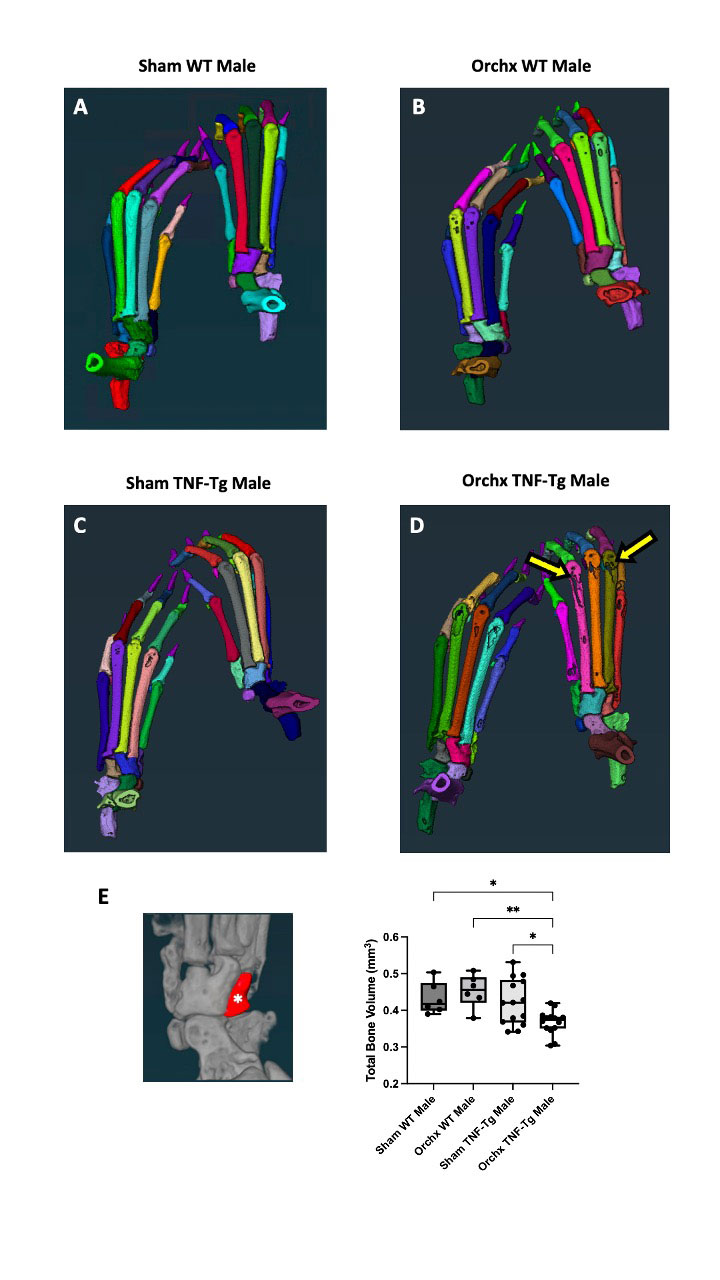Session Information
Date: Saturday, November 12, 2022
Title: RA – Animal Models Poster
Session Type: Poster Session A
Session Time: 1:00PM-3:00PM
Background/Purpose: Rheumatoid arthritis (RA) is characterized by chronic joint disease and is female predominant. The TNF-transgenic (TNF-Tg) mouse model of RA develops inflammatory-erosive arthritis and displays sexual dimorphism as the progression of joint disease and bone erosion differs between same age sexes and females die significantly earlier than males (1). The mechanisms behind these differences have yet to be determined. Studies suggest sex hormone variations as a possible explanation, with androgens providing a protective effect against joint disease and TNF-mediated bone erosion (2,3). We hypothesize that androgens’ anti-inflammatory effects mediate erosive arthritis progression.
Methods: Orchiectomies and sham control surgeries were performed on 4-week-old male TNF-Tg and wildtype (WT) mice (n=3-8 mice/group). Micro-computed tomography (µCT) scans of hindpaws were taken at 3-months of age for each group, and were compared with µCT data of same age TNF-Tg females (n=5). Cuboid bone volume (mm3) at 3-months was compared between groups, as the cuboid was detected as one of the earliest biomarkers of TNF-Tg erosive arthritis (unpublished data). Statistics were performed with a one-way ANOVA with Tukey’s post-test for cuboid bone volume comparison, and an unpaired t-test for comparison with TNF-Tg female bone volumes. Values are reported as the mean +/- standard deviation.
Results: 3D rendered segmented images of the hindpaws at 3-months of age showed significant bone erosion occurring in the periarticular regions of metatarsals in orchiectomized TNF-Tg mice not seen in same age sham TNF-Tg mice or orchiectomized WT mice (Fig 1 A-D). Orchiectomized TNF-Tg mice had significantly reduced cuboid bone volume than sham TNF-Tg and WT male cohorts (0.37 ± 0.03 Orchiectomized TNF-Tg; 0.42 ± 0.06 Sham TNF-Tg; 0.45 ± 0.05 Orchiectomized WT; 0.43 ± 0.04 Sham WT) (Fig 1E). There was similar cuboid bone volume between orchiectomized TNF-Tg mice and female TNF-Tg mice at the same age (0.37 ± 0.03 Orchiectomized TNF-Tg Male vs 0.36 ± 0.05 TNF-Tg Female).
Conclusion: Orchiectomized TNF-Tg mice have significantly less bone volume than other male cohorts, including sham TNF-Tg mice and orchiectomized WT mice. There was similar bone volume loss between orchiectomized TNF-Tg males and TNF-Tg females at 3-months of age, which suggests that bone loss in orchiectomized males may be equivalent to accelerated erosive disease in females. Erosions in the orchiectomized TNF-Tg distal metatarsal-phalange periarticular region are reminiscent of focal erosions seen in RA patients and also exhibit increased inflammatory erosive disease. These results suggest that androgens inhibit or delay bone resorptive activity from osteoclast and osteoclastogenesis that is accelerated by TNF-mediated inflammation. Further studies using in vivo androgen treatment and in vitro examination of androgen’s effects on osteoclast function are necessary to delineate androgen mediated inhibition of bone erosion and osteoclast development.
1. Bell R.D. et al. Arthritis Rheumatol 71(9): 1512-1523. 2019.
2. Traish A. et al. J Clin Med 7(12): 549. 2018.
3. Lashkari M. et al. Electron Physician 10(3): 6500-6505. 2018.
To cite this abstract in AMA style:
Chen K, Kenney H, Schwarz E, Rahimi H. Elucidating Androgen Effects on Focal Erosions in TNF-Induced Inflammatory Arthritis [abstract]. Arthritis Rheumatol. 2022; 74 (suppl 9). https://acrabstracts.org/abstract/elucidating-androgen-effects-on-focal-erosions-in-tnf-induced-inflammatory-arthritis/. Accessed .« Back to ACR Convergence 2022
ACR Meeting Abstracts - https://acrabstracts.org/abstract/elucidating-androgen-effects-on-focal-erosions-in-tnf-induced-inflammatory-arthritis/

